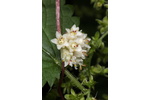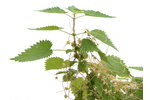Unique centromeres discovered in the European dodder
Whenever the European dodder, Cuscuta europaea, is under scientific scrutiny, it usually is due to its non-functional chloroplasts and its concomitant parasitic lifestyle. Scientists from the Czech Republic and Germany have now discovered another curiosity of this plant parasite. The chromosome areas responsible for proper segregation of genetic material during the division of the cell differ from those known from other plants.
European dodder (Cuscuta europaea) is a plant parasite. You can frequently find its thin, light-green stems wrapped around various members of the plant kingdom. Its special root-like organs protrude into the vascular system of the host to gain nutrients. Dodder does not have functional chloroplasts, which would enable the production of carbohydrates via photosynthesis, and thus has to rely on nutrients made by other plants. Now the scientists from the Biology Centre of the Czech Academy of Sciences in České Budějovice together with researchers from the Leibniz Institute of Plant Genetics and Crop Plant Research in Gatersleben discovered that C. europaea showcases a unique kind of centromere.
The centromere is a region on a chromosome, which facilitates the equal distribution of genetic information during the cell division. On the centromere, a special protein complex called kinetochore is assembled, and this, in turn, guides the attachment of the microtubules of the spindle apparatus (Picture 1).
 |
| Picture 1. Scheme of the centromere connection. |
In most eukaryotic species, the positioning of the centromere is determined by a centromere-specific histone CENH3. Based on the distribution of centromeres on the chromosome, species are thought of as having either monocentric or holocentric centromere types. In monocentric species, CENH3 and thus centromere activity is confined to a single region per chromosome, whilst in holocentric species, both are found along the entire length of the chromosome.
Second, the holocentric type was known right from some other Cuscuta species. However, when investigating C. europaea using modern immunological and microscopical methods , the scientists discovered a unique type of centromere. Although the spindle apparatus attaches along the entire chromosome, histone CenH3 occurred only in a few distinct regions per chromosome. The location of CenH3 histone, therefore, does not determine the spindle attachment (Picture 2).
 |
| Picture 2. Unique type of centromere in the European dodder. Blue = DNA (chromosome), pink = histone CenH3, green = microtupubles of the spindle apparatus; kinetochore is not labelled. |
To date, only a few species have been found where the kinetochore position is determined independently of CENH3 . These are mainly holocentric insects which, however, lack CenH3 entirely. Thus, the centromere type found in C. europaea is unique and its further investigation can shed light on molecular mechanisms determining the location of centromeres on plant chromosomes.
Publication: Oliveira L., Neumann P., Jang T., Klemme S., Schubert V., Koblížková A., Houben A., Macas J. (2020) Mitotic spindle attachment to the holocentric chromosomes of Cuscuta europaea does not correlate with the distribution of CENH3 chromatin. Frontiers in plant science 10: 1799: DOI: 10.3389/fpls.2019.01799














